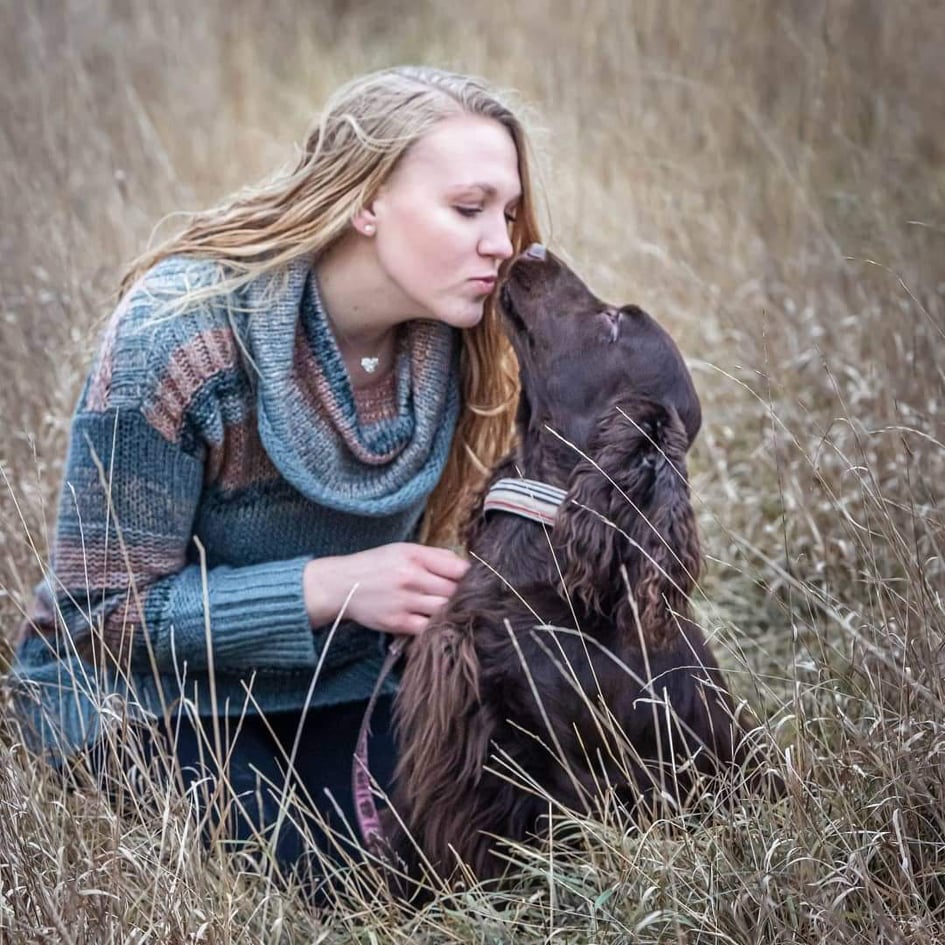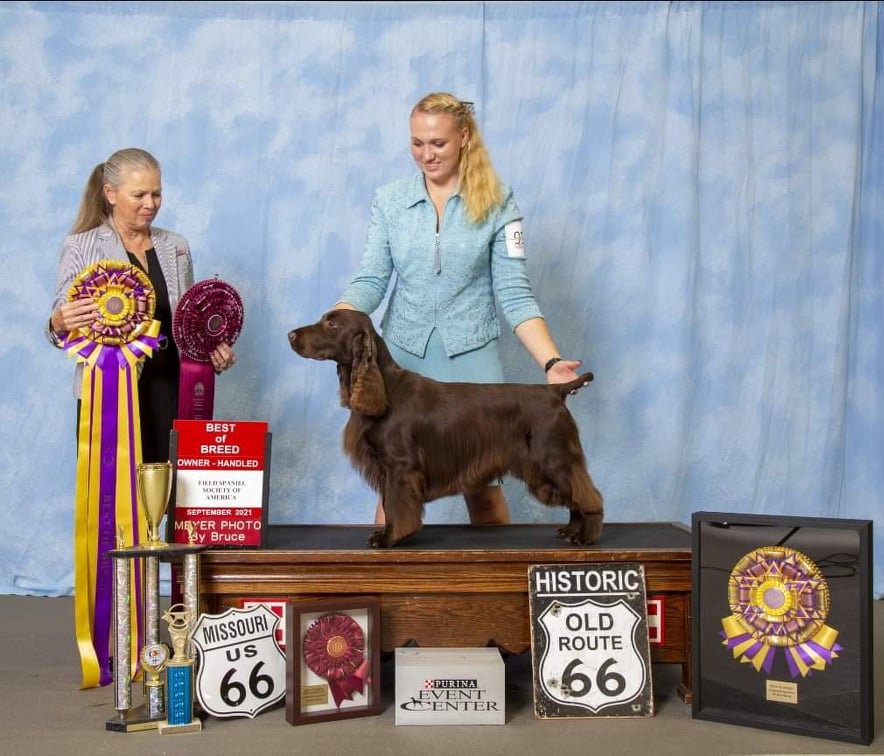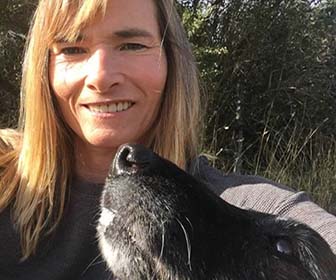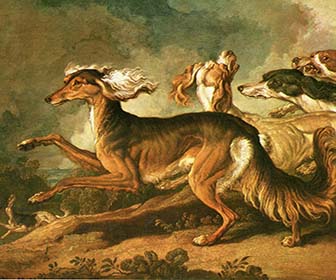Posts by Laura Reeves
509 — 12-Steps to a Happier You in the Dog Fancy
12-Steps to a Happier You in the Dog Fancy
I don’t know about you, but this holiday season I just haven’t had the vibe. I’ve honestly tried. But, all my magic spells for maintaining a positive attitude have been, at best, modestly successful. Even a week at the ocean didn’t cure me this time and that’s my solid go to.
Pretty sure I don’t have to run the litany we all know too well about the “why”. It’s just plain been a rough couple years. The global psyche is literally bruised and battered. Peace on Earth and goodwill to mankind seem like quaint notions of a bygone era. These notions could just as easily apply to the Ming Dynasty for all of their relevance in our world today.
What we all need is a 12-step program for happiness… Fortunately, I have just the thing! Lol
I wrote the following in 2015 for the now-defunct Best In Show Daily online mag back when I was a weekly columnist there.
These steps apply to our dog event world specifically, but can be generalized to daily life without much trouble in three simple rules. Just be nice. Get off your bleeping phone. Learn new things.
I may or may not have included this ditty in a previous episode, but if so, even I can’t find it! Lol
12-Steps to a Happier You in the Dog Fancy
January: Say “Congratulations” to the winner or “Thank You” to those who congratulate you. Yes, every time. Yes, even when the winner is your most bitter enemy, actually, especially then.
February: Watch one breed, other than your own, from start to finish, at every dog show you attend.
March: Instill and enforce the “first to look at their phone during dinner pays for everyone” rule each time you go out to eat, whether at a dog show, with co-workers or family. Experience the miracle of direct human interaction.
April: Seek out a club official — show chair, chief ring steward, hospitality chair, etc — at each dog show you attend and thank them, personally, for their hard work and compliment them on a specific piece of the show which you particularly liked. Resist the urge to complain about anything.
May: Volunteer to help at one show. Even if it is an hour of ring stewarding, helping with clean up or set up, judging a fun match, simply restocking the candy dishes or picking up someone else’s poopie. Do one thing for a club for no better reason than you can.
June: Help someone new. It could be as simple as assisting someone with an armband. Maybe a promising youngster with a new puppy shows up and would welcome five minutes of *kind* and constructive direction. It is important here to understand the concept of help. Focus on the positive. Just be nice.
July: Organize a potluck. Get a whole bunch of people together at someone’s RV or grooming space, even invite someone you don’t know well, break bread together. Laugh. Tell stories. Talk dogs. If there is a water balloon fight somewhere in the mix, this cannot be a bad thing. Remember, we’re still carrying each month’s goal forward, so March’s “no phone” rule applies. By now, it should be ingrained and much easier to implement.
August: Read the standard for a breed about which you know nothing. Then, at the next show, while continuing your February goal of watching a new breed, go find the breed you read about. See if you can apply elements of the standard to dogs in the ring.
September: Go back to school … In your own breed. Re-read your breed standard. Memorize it. Commit the entire standard to memory so thoroughly that you can quote entire sections verbatim. Then pull a random dog out of your pack, stack him up and go over him piece by piece according to the standard. Try very, very hard to be objective and not make excuses. Simply see what’s there and what isn’t.
October: Take the skeletons out of your closet. Look at them in the cold light of day. Whether as a breeder, handler, exhibitor or judge, take a look at your past mistakes, acknowledge them, then burn them at the stake and move on!
November: Talk turkey. Get off the internet blogs and approach a more experienced person about a question in your breeding program, grooming routine, handling skill set, whatever. Talk to them in person. Invite them to lunch or drinks. Do not expect miraculous secrets, but acknowledge and respect someone outside your comfort zone. You learn something new every day!
December: Give the gift of your time and energy to a local animal shelter, rescue group or other doggie emergency support system.
This 12-step program is guaranteed to bring enhanced enjoyment, satisfaction, curiosity, knowledge, camaraderie and success to anyone’s dog show calendar. Make the New Year the best ever!
I’m off to cook a simple Christmas Dinner for two, snuggle some dogs and curl up for a long winter’s nap.
Wishing everyone the gladness of Christmas, which is hope;
the spirit of Christmas, which is peace;
the heart of Christmas, which is love.
PureDogTalk’s ORIGINAL 12 days of Christmas…
On the first day of Christmas, my true love gave to me, a puppy in a sherpa bag…
(Caveat, never give a puppy for a Christmas present!)
On the second day of Christmas, my true love gave to me, two towel rolls for my puppy in a sherpa bag…
On the third day of Christmas, my true love gave to me, three air fresh’ners, two towel rolls for my puppy in a sherpa bag…
On the fourth day of Christmas, my true love gave to me four show collars, three air fresh’ners, two towel rolls for my puppy in a sherpa bag…
On the fifth day of Christmas, my true love gave to me, five cooooover ads… four show collars, three air fresh’ners, two towel rolls for my puppy in a sherpa bag…
On the sixth day of Christmas, my true love gave to me, six Sprinter tires, five cooooover ads… four show collars, three air fresh’ners, two towel rolls for my puppy in a sherpa bag…
On the seventh day of Christmas, my true love gave to me, seven shiny suits, six Sprinter tires, five cooooover ads… four show collars, three air fresh’ners, two towel rolls for my puppy in a sherpa bag…
On the eighth day of Christmas, my true love gave to me, eight sensible shoes, seven shiny suits, six Sprinter tires, five cooooover ads… four show collars, three air fresh’ners, two towel rolls for my puppy in a sherpa bag…
On the ninth day of Christmas, my true love gave to me, nine doggies dancing, eight sensible shoes, seven shiny suits, six Sprinter tires, five cooooover ads… four show collars, three air fresh’ners, two towel rolls for my puppy in a sherpa bag…
On the tenth day of Christmas, my true love gave to me, ten tongues a wagging, nine doggies dancing, eight sensible shoes, seven shiny suits, six Sprinter tires, five cooooover ads… four show collars, three air fresh’ners, two towel rolls for my puppy in a sherpa bag…
On the eleventh day of Christmas, my true love gave to me, eleven puppies squalling, ten tongues a wagging, nine doggies dancing, eight sensible shoes, seven shiny suits, six Sprinter tires, five cooooover ads… four show collars, three air fresh’ners, two towel rolls for my puppy in a sherpa bag…
And, on the twelfth day of Christmas, my true love gave to me, twelve friendly judges, eleven puppies squalling, ten tongues a wagging, nine doggies dancing, eight sensible shoes, seven shiny suits, six Sprinter tires, five cooooover ads… four show collars, three air fresh’ners, two towel rolls for my puppy in a sherpa bag…
508 – Breeding, Training and Socializing Decisions for High Drive Dogs
Breeding, Training and Socializing Decisions for High Drive Dogs
Denise Fenzi and host Laura Reeves take a deep dive into the breeding, training and socializing decisions we make with high drive dogs. Are we removing “hard” dogs from our gene pool in favor of “twitchy,” flashy high arousal dogs?
“So, drive always requires arousal,” Fenzi noted. “Arousal does not require drive. That is a good base. I like to recognize that and to recognize that arousal can hinder the dog’s ability to see the world clearly, so your socialization goes to hell, as the dog is so busy moving, they’re not actually taking it in.
“Then, when they’re three, they take it in and that’s a problem. ‘Cause for the first time they just saw a garbage can on wheels. It’s been there the whole time, they just never slowed down enough to see it. In training, we actually perpetuate that. What we do with these high arousal dogs is we work them. We get the toys and play, we focus on really early and they go for it, because they’re high arousal dogs, they need something to attach it to and so we actually undermine our socialization.”
This in-depth, experience-based discussion between industry leaders asks important questions and offers insight for breeders who want to learn more about breeding high drive dogs in any performance venue.
Laura Reeves: “I think it’s so important, when we talk about these things from the perspective of purebred dogs and doing events and doing sports and doing show, if that’s part of our consideration, all of those things it all is breed specific.”
Denise Fenzi: Absolutely
Laura Reeves: Starting at that instinct piece that you were talking about, the instinct has to be there and then you layer on all the rest of it.
Denise Fenzi: Yes. And then you’ve got your focus and all kinds of other things that are going to come into play. Even the definition. How do you define drive? My definition is “stays in the game under adversity.” So, it doesn’t matter what your game is and it doesn’t matter what the adversity is. It could be weather, could be bad training. There are dogs who are out there in crappy weather, under crappy training and I mean I don’t know how they do it, but they figure out what the trainer wants and they just flat on go forward. To me that’s drive … with a good dose of hardness
Defining and understanding drive, considering the inheritance patterns of drive and arousal, addressing anxiety as a corollary, Denise and Laura dig in to the hard topics, the difficult conversations and the implications of our breeding decisions.
Listen to part one here.
507 — Denise Fenzi on “Drive” vs “Arousal” in Dogs
Denise Fenzi on “Drive” vs “Arousal” in Dogs
Denise Fenzi, Founder of the famous Fenzi Dog Sport Academy, joins host Laura Reeves for Part 1 of this powerful and thoughtful conversation about what drives our dogs to the behaviors we see.
Denise and Laura discuss the difference between drive and arousal, and how that impacts on our dogs, particularly performance dogs, and some of the things that we as breeders need to consider when making breeding decisions.
“In the make-up of the dog, you’ve got the very bottom level,” Fenzi said. “Let’s call that instinct. Those are things that the dog does to stay alive. If you have a highly predatory dog and a rabbit goes by, the dog doesn’t think about what it’s going to do it goes. That’s the very bottom basic level. I will tell you that, in my opinion, this is where drives are rooted. So, the very bottom level is instinct in my opinion it is the hardest to change.
“Instinctually driven behaviors are very resistant to change. This is both good and bad because this is why your hunting dog goes out for an hour and does the thing. It’s painful, it’s hot, it’s tired, it’s cranky and it just keeps doing it and maybe it doesn’t even know why it keeps doing it, it just does the thing.
“One level up is the emotional level. That is where you have fear. Anxiety is linked to fear, it’s irrational fear, like you don’t even know why you’re afraid you’re just feeling anxious. You have happiness, you have anger, you have joy, you have caretaking for your young. So let’s call that the emotional level. Arousal can come from either one of those places… the bottom level the predatory drive instinctual base level, or it can come from the emotional level.
“Drive has a focus. Arousal is scattered movement. Focus sort of ties it altogether. If you have drive for a thing then you have to have focus or you just went out of drive. Now you’re looking at something else. Arousal gets complicated, because arousal can look like drive. (But) a dog can be in arousal and have no drive whatsoever.”
Listen to the whole show above to hear more.
Fenzi has titled dogs in obedience (AKC and UKC), tracking (AKC and schutzhund), schutzhund (USA), mondioring (MRSA), herding (AKC), conformation (AKC), and agility (AKC). She has two AKC obedience champions, perfect scores in both schutzhund and Mondio ringsport obedience, and is well known for her flashy and precise obedience work.
While a successful competitor, Fenzi’s real passion lies in training dogs and solving the problems that her own dogs and her students’ dogs present. She is a recognized expert in developing drive, motivation, and focus in competition dogs, and is known internationally as an engaging speaker and an expert in no-force training for sport dogs. She has consistently demonstrated the ability to train and compete with dogs using motivational methods in sports where compulsion is the norm.
506 – Pancreatitis: Acute, Chronic and Other Diseases of the Pancreas
Pancreatitis: Acute, Chronic and Other Diseases of the Pancreas
Dr. Marty Greer, DVM joins host Laura Reeves for a deep dive on Pancreatitis, a common ailment in our dogs seen during the holidays, and other diseases of the pancreas in dogs.
“Pancreatitis is inflammation of the pancreas. It is always an inflammatory condition. The pancreas is a very important organ in your body. It has two sections to it and it lives right outside your stomach and intestines. It does two jobs. One is it produces enzymes to digest your food and the other is it produces insulin to control your blood sugar.
“There’s a couple of different kinds of pancreatitis. There’s acute and chronic pancreatitis and then there is Exocrine Pancreatic Insufficiency (EPI) and then there’s diabetes. Those are the most common disorders that we see in the pancreas and the dog we can also on rare occasion see pancreatic tumors they’re called insulinomas. (They’re) not common … we see on average maybe one of these every couple of years … if we do see pancreatic cancer it tends to be the insulinoma kind, which causes the blood glucose to drop too low and then the dogs will come in with a seizure type of activity.
“Most pancreatitis is associated with vomiting. About 90% of the dogs with pancreatitis present with vomiting. The reports are about half will present with abdominal pain. I can tell you having had four episodes of pancreatitis, that if your dog turns around and tries to bite your veterinarian during the time that they’re feeling their abdomen, palpating it to check if there’s any abnormalities that they can feel like masses or foreign bodies or anything, that dog is justified in biting the veterinarian because there is nothing that hurts much worse in my experience than pancreatitis.
“(The cause) tends to be … the dog knocks over the trash and eats the drippings from the Turkey or the chicken or the ham fat or the scallop potatoes. One of those kind of fatty meals that are associated with what we do at the holidays.
“That’s a fairly typical history, but even without that high fat meal, we can still see pancreatitis. We also can see some of these patients that have recurrences, so they become that low grade chronic pancreatitis patient. Those dogs have to be managed long term very carefully on low fat well managed diets so that the patient doesn’t have recurrences and flare ups. Eventually too many episodes of pancreatitis we feel can probably cause scarring of the pancreas and potentially lead to diabetes.”
505 – Front and Center with Stephanie Seabrook Hedgepath
Front and Center with Stephanie Seabrook Hedgepath
Stephanie Seabrook Hedgepath and host Laura Reeves are back, chasing squirrels and discussing the single most important part of canine structure and anatomy: the front assembly.
“If you have a bitch and her front assembly is not what you really want,” Hedgepath said, “what you gotta do is you gotta find a dog that has the front assembly you do want, which is not easy in any breed. The hardest thing to put on a dog’s that front assembly. Once you find dog, …when you do that breeding, don’t be taken in by that precious little beautiful face if it doesn’t have that front assembly you’re looking for.
“We all started somewhere. You have to work at it. You have to train your dog. You have to select the proper dog. You have to learn and know what you’re seeing. Some people get lucky and they get a magic wand and their first dog is a big time winner. Most of the rest of us work our (butts) off for a lot of years.
“Learn your history. Learn what your dog’s about, even if it’s a relatively modern dog and do not try to make it something that it isn’t.
“I’ve never been one that thought that movement and type were two different things. They’re the same thing, because every dog moves according to his type and how he’s put together. Movement is an integral part of type. Movement is actually the proof of structure.
“I mean let’s just say an Old English Sheepdog and its movement and a Bearded Collie and its movement. Both fuzzy dogs, long hair and they come from kinda the same areas and totally different breed type. They worked in different train and different styles of working.
“This is something I cannot say enough times, the work that a dog was designed to do informs the structure it has to do the job the people needed it to do to live. Whether it was to put meat on the table or to have meat to sell or to be a poacher or whatever, whatever it was kept the food on the table.
“We’re fortunate today that, yes, we can breed for pretty. But what good is it if it doesn’t still represent the breed it was supposed to be. The concept of preservation breeding is to preserve the dog. It was designed to do the job, even if it doesn’t still do the job, it should be able to do so.”
In summary, front assemblies are important. They are different between types of dogs based on the work the dog was bred to do. If you are breeding dogs and looking to create better front assemblies, you have to select for the puppy that has the correct front assembly when you evaluate the litter. Once you’ve selected a good front, you have to train the dog so that the judge can actually see the movement that proves the structure.
For more episodes around this topic check out here and here.
504 – Dog Trainers and Dog Breeders Working Together
Dog Trainers and Dog Breeders Working Together

Kayley Paylor and her Azawakh.
Kayley Paylor, like many professional dog trainers, started in her profession after acquiring a rescue dog that had issues. She became a huge advocate for the predictability and reliability of well-bred purebred dogs as a result. Paylor joins host Laura Reeves to tackle the “elephant in the room” when it comes to dog breeders and dog trainers working together.
“It’s one of those issues where you don’t even realize that that type of (animal rights) agenda is sneaking in because the line between animal welfare and animal rights activists is a tough one,” Paylor said. “People who love their dogs and want the best for their dogs and trainers who want the best for dogs, it’s really easy to lose track of what is actually best for them in the long term. Are we going to let them suffer with mental issues when we could just clarify the issue immediately with a consequence once that is appropriate.
“So, what I tend to see and what I ran into is, again, really well-intentioned individuals who get a rescue as their first dog. Mine had health problems, as is unfortunately common, and I didn’t know that going into it. Epilepsy, dental issues, that type of thing. And some behavioral issues that come with, certainly, genetic temperament issues, but also just they didn’t have a breeder that cared about the puppy, that gave them the solid foundation.
“I dug into the behavioral issues and what I started to see, when I went through my apprenticeship, … I saw all of these incredible women who had these purebred dogs that were predictable. That you could understand exactly what was going to happen. And so I started to understand ‘oh, OK, you understand exactly what you’re going to get when you get that dog.’ I was lucky and I wasn’t the only one. All of my colleagues that came in at the same time as I did all came from a rescue background.
“All of my colleagues went that way, where we started with rescues and ended up with purebred dogs. Because if you rescue dogs, you have to understand you’re not getting anything predictable. You don’t know the background.
“From a breeder perspective, I do wish that breeders had a little bit more trust in trainers … but it’s just a breakdown in communication. Neither of them see all the good that the other one can do because of the bad in both communities.
“It’s just about getting those well-bred dogs in front of trainers. Even if you know what you’re doing. Even if you think you know what you’re doing, taking them to a puppy group class for puppy play.
“On both sides of the issue let’s just say R+ versus a balanced perspective, you’re going to get people who understand dogs and their different needs and their different drives, and you’re going to get people who don’t.”
Listen to the entire episode above and hear Paylor’s insights on finding a good fit for a trainer to work with, training insights and so much more.
503 – Examining the History of Sighthounds with Bo Bengtson
Examining the History of Sighthounds with Bo Bengtson
Bo Bengtson, author, publisher and Whippet breeder, attended his first dog show in 1958 in his native Sweden. He joins host Laura Reeves for a deep dive into the intricacies of sighthounds.
“It was, right away, like lightning struck,” Bengtson said. “I was 14 years old and I just knew right away that this was what I wanted to devote my life to. It was really fascinating. It was, as someone once said, a combination of zoo and circus and theater …
A passion for sighthounds
“You have to know a little bit about coursing if you’re involved in sighthounds. They have remained the same for thousands of years, the basic type. They weren’t breeds early on but different types of sighthounds. if you look at the early description of coursing which is the pursuit of game with sighthounds … that is a sport that’s now these days illegal in most of US… It’s been superseded by lure coursing, which is an artificial form of coursing.

“Hunters Homeward Bound,” 10th Century AD. Courtesy of Bo Bengston.
“(Sighthounds developed) before firearms basically, when the only way you had to hunt was through the dogs and whatever they could course and kill was basically today’s dinner. Firearms made sighthounds very much superfluous. And I think the sport then became very much a status symbol. (Sighthounds) are of course aesthetically pleasing and so many rich people and aristocratic people preferred to hunt with sighthounds, not because of need but because it was a beautiful spectacle and pretty expensive spectacle too. In various parts of the world, Queen Elizabeth I was very fond of coursing. In Russia they coursed with Borzoi. And in the Far East there were Salukis.
What IS a Sighthound?
“There is no official definition of what a sighthound is. So there is a great disagreement about what breeds actually count as sighthounds. You can count as few as four or five as pure sighthounds and as many as 40 as “sighthound related” or different types of breeds we don’t know in this country. Some we wouldn’t define as breeds but more as types.
(Listen to fascinating conversations about the Caravan Hounds of India here and here.)
History of sighthound development
“I think we have to go back again a couple of thousand years because there have probably always been different sizes of greyhounds. Greyhound types. The big ones which were the ancestor of the modern greyhound. And we have the different, smaller ones that were ancestors of whippet and the Italian greyhounds. I think that Whippets, although they weren’t described as a breed until late 1800s, they have certainly been around much longer. Catherine the Great of Russia had little English greyhounds she called them. And they were very important to her. She nursed them herself and they slept on a pink couch in her bedroom. But whether they’re Italian greyhounds, whether they were whippet, who knows. I mean they were very small and whether Italian greyhounds or whippets, it is kind of irrelevant these days.
“The Greyhound and the Saluki are sort of the “ur” sighthound, what sighthounds are supposed to be like. … if you take one step away from Saluki you get the Afghan Hound, which is a little more powerful. If you take several steps away from the Greyhound, you get the Ibizan Hound and you get the Portuguese Podengo and that kind of thing.”
Listen to the full episode for more detailed insights into all things sighthound.
502 – Seizures in Dogs: Causes, Treatments and Considerations
Seizures in Dogs: Causes, Treatments and Considerations
Dr. Marty Greer joins host Laura Reeves for this month’s Veterinary Voice talking about seizures in dogs. Type of seizure, age of onset, causes and treatments are all up for discussion today.
“Seizures can be actually epilepsy, which has probably got a genetic component to it,” Greer said. “Where the dog has an epileptic tendency. Typically those are going to be seen in certain breeds of dogs and they typically happen between two and four years of age for the first seizure. If we’re seeing seizures or seizure type activity or episodes in really young dogs or dogs that are elderly, it’s probably not primarily an epileptic situation.
“If it’s a very young puppy, the first thing we look at is blood glucose. If their glucose drops because they’re not eating adequately, they don’t have enough glycogen stores in their liver, and so they’re weak or they’re sick, they’ll have a seizure type of activity. So, the first thing we do in anything that’s really young or really old, is reach for some kind of glucose. You can reach your Karo syrup, you can reach for honey. If you have caramels and the dog is capable of chewing them, that’s great. You can give sweetened condensed milk. Glucose can be absorbed right through the gums, so the dog doesn’t actually have to swallow to get the effect of bringing up their glucose.
“If you have an older dog (with seizure activity) the first thing to do is get some initial blood work. That’s easy to do. You can check calcium, you can check glucose. It’s easiest and most effective to check it very close to the time of the event. Glucose can go down for multiple reasons. I’ve seen it go down during severe pregnancy toxicosis. I’ve seen it go down because dogs have eaten xylitol, sugarless gum and candy. And I’ve seen it go down because dogs have insulinomas, which is a tumor in the pancreas. Those are functional tumors that create so much insulin that the dog’s blood glucose drops precipitously. Anytime your glucose is too low you can have a seizure. I’ve also seen it go down in Addison’s disease.
“You want to be sure that you’re comprehensive and complete on what’s going on with the dog before you jump to any conclusions. There’s always the toxins. So, xylitol we’ve talked about as a possible toxin, but there are some rat poisons and some other neurotoxins that we can see not the vitamin K type of rat poison. There’s a lot of other kind of nasty toxins that are out there that dogs can sometimes get into. Sometimes our pharmaceutical medications can cause that as well, so appetite suppressants can cause it, there are a number of different drugs on the market that can cause seizure type of activities. It’s really important that we get a good history on these drugs what they might have gotten into.
“The other thing to know is that the new class of oral flea and tick medications can cause neurologic disease tremors. That can also include seizures in seizure prone dogs. If your dog recently had a dose of that, typically within 24 hours, you need to include that too. So you need to go through the list of anything that’s possible, anything that’s the dog was given deliberately or not deliberately so that we are not missing any information that could potentially be a problem.
“Of course, in the older dog, there are structural abnormalities like brain tumors. That’s diagnosed with either CT scan or an MRI … there’s a lot of things that make dogs look like seizures, but it’s not always epilepsy. Epilepsy is a diagnosis of exclusion. Typically, we diagnose it after everything else has been ruled out.”
Listen in to the podcast for Dr. Greer’s suggestions on treatment plans and more.
And go back to Liz Hansen‘s conversation on the research in this area.
“The Rest of the Story” — From Craigslist to Number One Field Spaniel
“The Rest of the Story” — From Craigslist to Number One Field Spaniel
 Mikala Seymour and her Field Spaniel, Riley, are an impressive team. Riley, GCHB CH Bruce’s Living the Life @ Upland, is currently the number one field spaniel all-systems and a national specialty winner, entirely owner-handled. This is a significant accomplishment for anyone. But “the rest of the story” is the impressive part.
Mikala Seymour and her Field Spaniel, Riley, are an impressive team. Riley, GCHB CH Bruce’s Living the Life @ Upland, is currently the number one field spaniel all-systems and a national specialty winner, entirely owner-handled. This is a significant accomplishment for anyone. But “the rest of the story” is the impressive part.
Mikala just turned 18 years old. And Riley came to her through Craigslist, as a three year old. A junior handler and a backyard dog teaming up to successfully take on the dog show world is not an everyday occurrence.
 “He was actually found for sale on Craigslist by my mentor,” Mikala said. “He was down in Texas. Three people piled together and were able to get him up here. My mentor when she finally got him had a table with her. She put him on the table, racked him up and said ‘underneath this mess of a dog’ ’cause his fur was matted and disgusting ‘there’s a really nice dog under here. I think it needs Mikala’s touch’ pretty much is what she said. She ended up cleaning him up a little bit and shipping to me. That’s when I started putting in the hard work. I had to teach him how to run, I had to teach myself how to groom. It was a good almost year of learning for me and we created a special bond and we’ve just gone from there.
“He was actually found for sale on Craigslist by my mentor,” Mikala said. “He was down in Texas. Three people piled together and were able to get him up here. My mentor when she finally got him had a table with her. She put him on the table, racked him up and said ‘underneath this mess of a dog’ ’cause his fur was matted and disgusting ‘there’s a really nice dog under here. I think it needs Mikala’s touch’ pretty much is what she said. She ended up cleaning him up a little bit and shipping to me. That’s when I started putting in the hard work. I had to teach him how to run, I had to teach myself how to groom. It was a good almost year of learning for me and we created a special bond and we’ve just gone from there.
“He was pretty much someone’s pet that they barely did anything with. They barely socialized him or anything. But he is the sweetest little thing. He just wants attention and he’s done so much for me. He’s learned to tolerate a lot too, with the grooming and stuff. He wasn’t too happy about it at first, but once he figured it out, he’s getting to be good with it now.
“I’m actually third generation with this. We started in Saints. I started showing Saints as well in juniors and in the bred ring. (That’s) the breed that I fell in love with. It made me want to continue doing this. And then somebody said I should try a sporting dogs to be a little more flashy over the big drooly Saint, so we tried that and it just kind of snowballed from there.”
Mikala offered her top three tips for anyone who wants to be successful with their dog in the ring:
- Find what makes your dog click. Get inside their head. “Learn what makes your dog special and get that connection with them so that they want to please you.”
- Always talk to people. Learn more about your breed. Learn about other breeds. Get advice from other people with your breed. “Learn from them and take everything with a grain of salt ’cause everyone’s gonna have a different opinion. You have to do what’s right by your dog, while still listening to their advice and thinking about ‘is this gonna work for my dog or can I use this tip but do it in a different way, so it works better for my dog’ kind of a thing.”
- Just have fun with it and do your best. As long as you’re having fun, you can’t go wrong.
Episode 500!!! Celebration of Pure Dog Talk!
Episode 500!!! Celebration of Pure Dog Talk!
Welcome to Pure Dog Talk! I am your host Laura Reeves…..
These words hit the airwaves for the first time almost exactly five years ago … Five HUNDRED times later, I still have to think about my tone and cadence and inflection. Maybe just a bit less these days lol… Sort of like you guys learning to show your dog, I am entirely self-taught how to do this job and I am eternally grateful that you all have joined me in what has been a pretty incredible journey.
Today’s episode is a pure cork popping, champagne swilling celebration of our tribe. YOU guys shared some amazing stories about how this show has impacted your life in dogs. I dug around and pulled out some of MY favorite guests and interview moments.
Pure Dog Talk is not and never has been *static.* It lives and grows, often faster than I can keep up! As we move forward in the coming years, there will be changes, of course. For example, I’ll once again be podcasting *exclusively* on Pure Dog Talk. I’ve stepped waaaay outside my comfort zone and will be offering more Facebook Live and Webinar opportunities here at Pure Dog Talk (like the K9 First Aid 911 series with Marty Greer that is available on the website now) as well as moving back to more of the pre-pandemic live seminars and panel discussions over the course of the coming year.
But mostly, I wanted to say thank you. To ALL of you. My listeners, my guests, my patrons, my sponsors, my supporters and even the best compliment of all, my competitors. You have all made me better at this role than I could have ever dreamed of being. My goal of offering meaningful education, FOR FREE, to as many people in our sport as I could possibly reach has absolutely come to pass.
Thank you for taking me with you on your drives, your workouts, even your lawn mower… I am deeply honored to keep you company while you bathe, trim, condition and clean up after your dogs. Thank you for caring, so very much, about your dogs, your breeding programs and the sport of purebred dogs. Without your single-minded dedication, they would all cease to exist.
Following are just a few of the hundreds of Stories of impact from our listeners:
Diane Davis
I first heard about Pure Dog Talk when something came across FaceBook about a handler friend of mine being interviewed about the Professional Handlers Association and how to hire a professional handler to show your dog. I listened to the episode and thought it was well done, so I decided to try listening to a few more. I was pleased to discover that these were also well done and informative. I have about a forty-minute commute to work so I began to listen while driving back and forth. It wasn’t long before I got caught up on the episodes that I thought would be interesting. But as I started to go through some of the others, what I discovered was that I learned something from every episode. I began to look forward to the new episodes coming out and would listen to them several times so I didn’t miss anything.
Pure Dog Talk has become a big part of my life. I love learning about other breeds. The episode about the Bracco Italiano brought back a memory of the Bracco Axel floating around the ring to win the World Challenge Cup at Eukanuba the year I was there. I loved hearing about judges. As an owner-handler I always felt that judges were kind of unapproachable, but the interviews helped me to see that they were people too. Veterinary Voice with Dr. Marty Greer was invaluable. The episode on pyometra gave me the tools to advocate for my girl with my vet when she developed pyometra on her first heat cycle. We were able to medically manage her condition and she has since had two litters. And speaking of puppies, Pure Dog Talk has taught me a lot about breeding, whelping and raising puppies. I hadn’t bred a litter in nearly seven years because my last litter had been so hard, but with new knowledge, and new resources I have bred and raised two litters this year.
Then 2020 happened. Covid19 happened. Dog shows disappeared from the Pacific Northwest for over six months. Uncertainty about health, finances, family, friends was ever present in everyone’s life. But through it all, the Pure Dog Talk podcast was one of the few things that was stable. The Patrons “After Dark” was created so once a month we could meet via Zoom and talk about dogs, have an adult beverage and feel somewhat normal. When we had the first retreat in Montana in September 2020, we realized we had created a wonderful community of dog people and a “safe space” for everyone involved. The virtual dog shows were fun and a way to participate in some small way, a dog show. I know that I speak for other as well when I say these activities helped keep me sane during that crazy year.
As everyone in dogs knows, things are never easy. There are disappointments and body blows. There are emergencies, vet bills, money issues and just plain exhaustion. But the Pure Dog Talk podcast seems to have uncanny timing and usually is talking about a subject that I need to hear about when I need to hear it. And when I look into the eyes of my dogs, it is all worth it. I wouldn’t trade them or my life with them for anything. When you know better, you do better. Thanks Pure Dog Talk for everything you’ve given me and my dogs.
I’m Tracey Rives, Montgomery, AL, a breeder/owner/handler of Havanese dogs.. I just recently discovered your podcast “Pure Dog Talk “. Your recent podcast with Amanda Kelly, Parts 1 and 2, sparked a fire in me as an owner handler and my journey for showing dogs. It was so inspirational for me. As an owner handler I crave information in every way and your podcast is priceless in supplying great unbiased information. My goal is to encourage breeders/owners to learn to handle their own dogs. I’m afraid it’s becoming a lost art. Showing my bred-by dogs to their championship is one of the top five most gratifying things I’ve done.
MY STORY: I took my bred-by boy, Manny, (18 months old, not even a grand yet) to our Havanese National Specialty in Orlando, FL, 2016 with my buddies “Southern Magnolia Kennel Club”. Our second National. Totally no expectations whatsoever – zero, zip, nada, nothing. Really the goal was to rub shoulders with the best of the best and learn, learn, learn – not to mention drink wine and dine and fellowship with my favorite peeps. I found myself in the ring with 36 or so of the best Havanese dogs (not including bitches) in the country. Made the first cut. Wow!! Ok. Went back in. Made the second cut. Holy shit! Ok. We won the whole damn thing!!! That did not just happen. My exact words to my husband when I called him immediately after the win when apparently I should have been first in line getting our win photo. Who knew?? LOL!! By default, I opted to be the last in the photo line. Just had too many friends to hug. It’s still surreal to this day.
So the reason I’m submitting this is looking back over the last several years as a “hobby” breeder/owner/handler of Havanese, it’s really about learning to run the race gracefully. Win or lose, for me it’s about sharing my passion with my people. Because seriously, at the end of the day, without the sweet memories, it would be just another dog show.
Kayley Paylor:
I started in conformation at the request of my boy’s breeder. An Azawakh is far from the easiest dog to start with, sighthounds with guarding instincts aren’t exactly the easiest dog to convince to stand for exam. We took handling classes, debuted in the ring before the breed had been fully AKC recognized, and he took Best in Miscellaneous. We showed again a few weekends later and my boy had suddenly hit adolescence, his guarding instincts were developing, and he wanted nothing to do with the judge. We muddled along for the next two years with varying degrees of success.
During that time I have the distinct memory of having drinks with a good friend who had started showing the same weekend I had. We were taking about show dogs and she recommended a podcast called Pure Dog Talk that she’d discovered. I wasn’t really the podcast type but I decided to give it a shot. I started putting it on on the commute to work and driving to and from shows and trials.
The very first episodes I listened to were the three part Bill Shelton episodes on building a family of dogs. In the intervening time since I’d brought home my first show and performance dog, I’d added a foundation bitch who I had chosen because her pedigree complemented my boys, she had beautiful drive and focus, and her structure at 8 weeks was again complimentary to my dog’s. Listening to Bill Shelton talk about developing two bitch lines that you can work between solidified the idea I’d had bouncing around in the back of my brain of adding a second bitch. Four months later I lucked into adding a perfect second bitch from completely different lines but complimentary to my male on different ways.
Since then Pure Dog Talk has been integrally woven into my life. I travel often both for my work as a dog trainer and for shows and performance events. Over the past two years I’ve driven more miles than I care to count. Pure Dog Talk was there for all of it. I’ve listened to Dr. Marty Greer give whelping advice on my way to Open Field Coursing, I’ve listened to experts like Dr. Gayle Watkins, Bill Shelton, Dr. Teresa Nesbitt, and so many more give advice and valuable insight on a dizzying array of topics on my way to everything from Royal Canin to UKC Premier to LGRA straight racing, lure coursing, and agility trials. And through it all the one constant: Laura Reeves’ dulcet voice guiding us through preconceptions, prejudices, and recording this information for the history books.
I grew up playing team sports and having a strong community is both revitalizing to me and so useful as a sounding board. That is what Laura has built with Pure Dog Talk: a community, a tribe as she often calls it.
I can go to the patrons group with any questions and not be judged for them. I have always struggled with confidence handling my dogs in the show ring. I don’t normally have stage fright at performance events but I would just get into the show ring and shake, which of course affected my dogs. But after the mock show at last summer’s retreat where my COVID Azawakh puppy showed very well, I left the retreat finally confident that I was supporting my dogs and presenting them to the absolute best of my ability. And when my car failed at the patrons get together this March, Laura graciously made room for my dogs so they didn’t have to sit in the cold car while I waited for a tow truck. That is what true community is about. That is how we keep people new to our sport around.
In many ways Pure Dog has been an instrumental resource for me over the last couple of years, not just for the handling tips but also the whelping information as I get ready to whelp my first litter. Pure Dog Talk is an invaluable resource for the purebred dog community and I’m eternally grateful to Laura for undertaking this podcast and for other listeners and patrons for supporting it and helping it become the resource it is today.
Christina Rozema
I wanted to give you another thank you update. Your podcast supported me showing my bull terrier bitch Freyja and with the wackiness of 2020 she became the top Bull Terrier in Canada. Sure there were ‘t many shows but there weren’t many for everybody equally. Then as I binge listened time-out breeding podcasts with Dr Greer and with Avidog, I planned her breeding with frozen semen imported from Poland to an amazingly successful litter of 11 who are now 3 weeks old.
You helped me build my courage, keep up my spirits, and feel confident enough to go ahead with her breeding.
Thank you thank you thank you. You have made such a difference in my life and the life of my dogs. I just wanted you to know.
Feedback from you guys gives me courage when things are tough to keep going. I am so grateful for our tribe.
So now, just a few comments from some of MY favorite guests and conversations over the last five years….
…..
There are so many more moments, episodes and conversations to be had. Watch this space! The next five years are guaranteed to be chockablock with knowledge shared.










